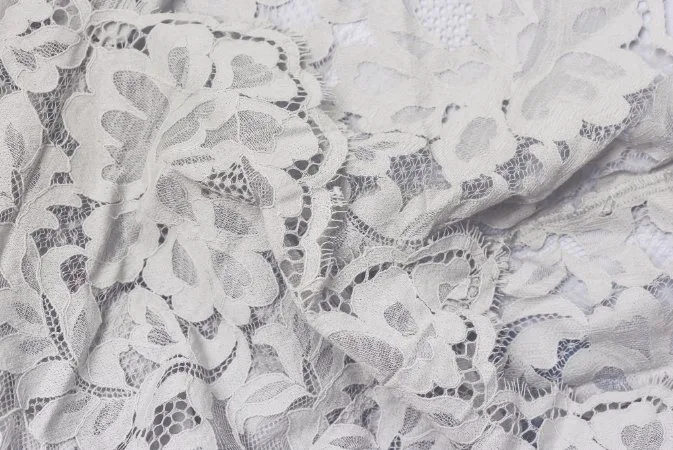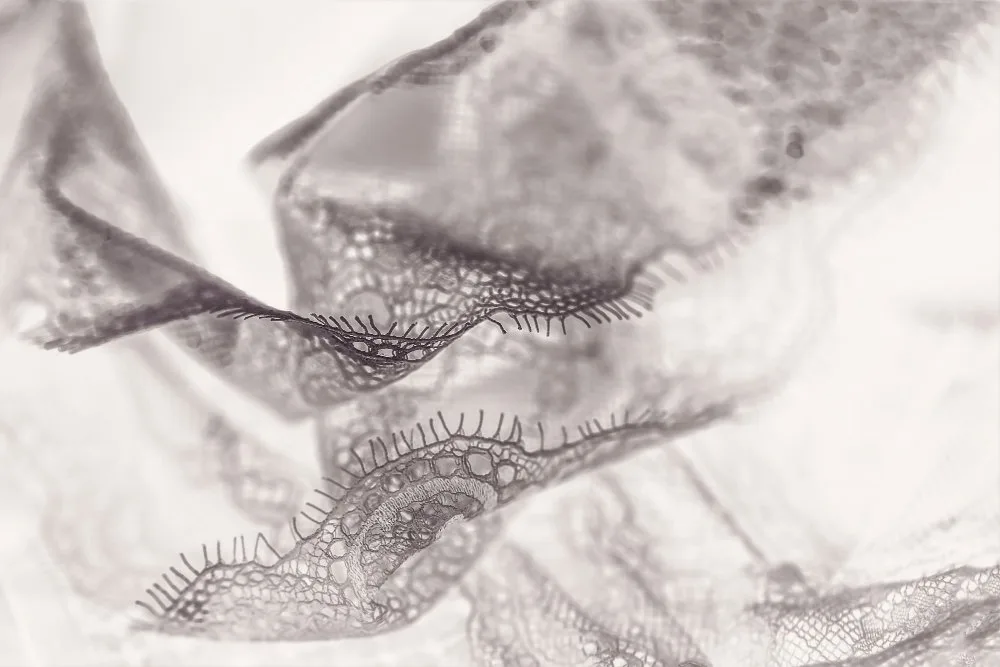Master Corded Lace: From Fabric Selection to Professional Sewing Techniques
Have you ever wondered why some lace fabrics look more luxurious and hold their shape better than others? The secret lies in a special type called corded lace. This fabric features raised patterns outlined with thick threads or cords, giving it a three-dimensional look that regular lace just can’t match.
Unlike flat lace fabric, corded lace adds texture and structure to your projects. Whether you’re planning a wedding dress, updating vintage clothing, or creating elegant home decor, understanding this fabric will help you make better choices for your sewing projects.
Table of Contents
What is Corded Lace?
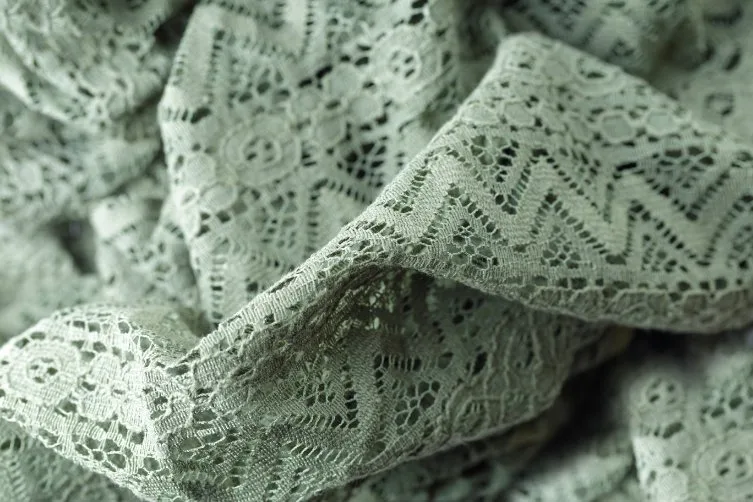
Corded lace is a special type of decorative fabric where thick threads (called cords) outline the lace patterns. Think of it like drawing around a coloring book picture with a thick marker. The cords create raised lines that make the design pop off the fabric surface.
This technique started in northern France, where it was originally called Alençon lace. Today, manufacturers around the world create corded lace using both traditional and modern methods. The cords can be made from silk, cotton, polyester, or even metallic threads, depending on the look you want.
How Corded Lace Differs from Regular Lace
Regular lace lies flat against your fabric, while corded lace creates shadows and depth. Here’s what makes it special:
- Raised patterns that you can feel when you run your fingers across the fabric
- Better shape retention because the cords help the fabric hold its form
- More durability since the cords prevent tearing along pattern lines
- Enhanced visual appeal with light and shadow effects
Understanding Lace Terminology
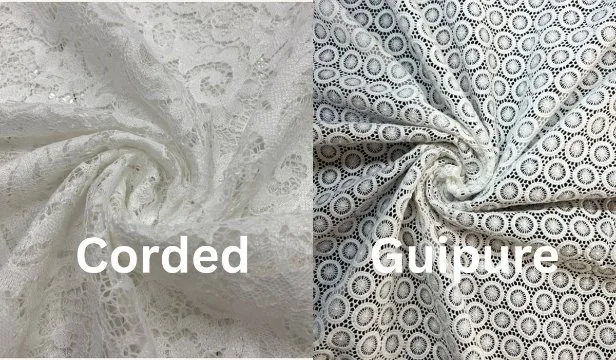
Is Guipure Lace the Same as Corded Lace?
No, guipure lace and corded lace are different, though they’re sometimes confused. Guipure lace connects its patterns with bars or threads instead of using a mesh background. Corded lace can have either a mesh background or be constructed like guipure, but it always has those distinctive raised cord outlines.
What is Lacing Cord?
Lacing cord refers to the actual thread or yarn used to create the raised outlines in corded lace. These cords can be:
- Fine and delicate for subtle texture
- Thick and bold for dramatic three-dimensional effects
- Smooth or textured depending on the desired finish
- Matching or contrasting colors to the base fabric
Laced vs Unlaced Cord
In fabric terms, “laced” cord means the cord is woven or integrated into the lace pattern during manufacturing. “Unlaced” would refer to separate cording that you might add later, though this isn’t common in commercial corded lace production.
What is a Hole for a Lace or Cord?
This refers to eyelets or grommets in fabric where you can thread decorative cords. While not directly related to corded lace fabric, these holes are often used in garments to add functional or decorative lacing details.
Types and Materials of Corded Lace
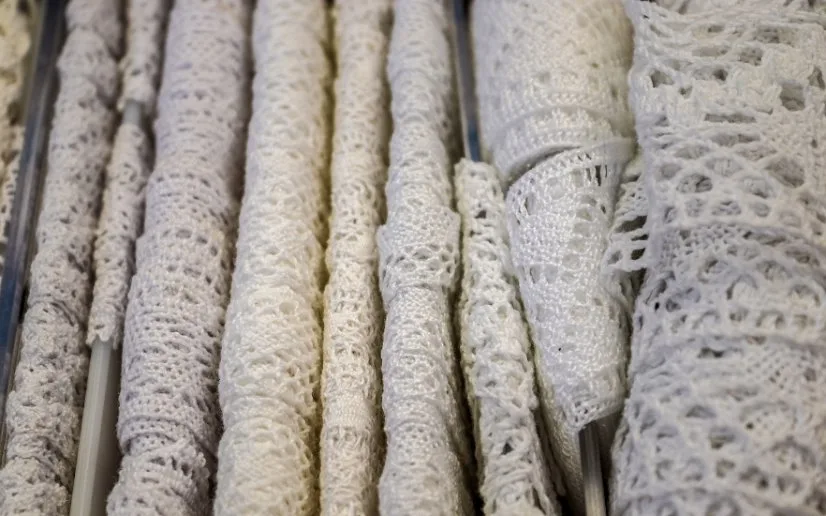
The material you choose affects how your finished project looks, feels, and performs. Here’s what you need to know about each option:
Material Comparison Table
| Material Type | Best Features | Ideal Projects | Price Range |
|---|---|---|---|
| 100% Polyester | Machine washable, wrinkle-resistant, affordable | Home decor, practice projects, children’s clothing | $15-$40/yard |
| Cotton Blends | Breathable, soft drape, natural feel | Bridal wear, blouses, formal clothing | $50-$120/yard |
| Polyamide-Viscose | Stretch recovery, lustrous sheen, form-fitting | Evening gowns, fitted dresses, structured garments | $80-$180/yard |
| Silk Blends | Luxurious feel, excellent drape, premium quality | High-end bridal, couture projects | $150-$390/yard |
Choosing the Right Weight
Corded lace comes in different weights, and picking the right one matters for your project success:
Lightweight (under 4 oz/yard):
- Perfect for overlays and veils
- Drapes beautifully over other fabrics
- Best for delicate, flowing designs
Medium weight (4-8 oz/yard):
- Great for most garment construction
- Provides good structure without stiffness
- Versatile for various project types
Heavyweight (over 8 oz/yard):
- Ideal for structured pieces like bodices
- Holds its shape well
- Best for garments needing support
Learn more about fabric weights in our guide to lightweight vs heavyweight fabrics.
Fabric Care and Maintenance

Proper care keeps your corded lace looking beautiful for years. The raised cords need special attention to prevent flattening or damage.
Pre-Washing Guidelines
Always test a small piece first, then follow these steps:
For Cotton and Cotton Blends:
- Hand wash in cool water with gentle detergent
- Rinse thoroughly without wringing
- Lay flat on clean towels to dry
- Never hang wet lace fabric
For Polyester Blends:
- Machine wash on gentle cycle in cool water
- Use mild detergent and skip fabric softener
- Air dry or use low heat in dryer for just 10 minutes
- Remove while slightly damp to prevent over-drying
For Delicate Fibers (Silk, Viscose):
- Hand wash only in lukewarm water
- Use specialized delicate fabric detergent
- Rinse gently and roll in clean towel to remove excess water
- Lay flat to dry away from direct sunlight
For more detailed care instructions, check our guides on cotton care and synthetic fabric care.
Pressing and Ironing Techniques
The key to pressing corded lace is protecting those raised details:
- Use a press cloth – Place a clean cotton fabric between your iron and the lace
- Set iron to appropriate temperature – Cotton setting for natural fibers, synthetic setting for blends
- Press, don’t drag – Lift and place the iron rather than sliding it
- Work from the wrong side when possible to protect cord details
- Use steam sparingly – Too much moisture can distort the cords
Storage Tips
- Roll rather than fold to prevent permanent creases in cord areas
- Use acid-free tissue paper between layers if folding is necessary
- Store in breathable garment bags to prevent moisture buildup
- Keep away from direct sunlight to prevent color fading
Sewing Techniques for Corded Lace
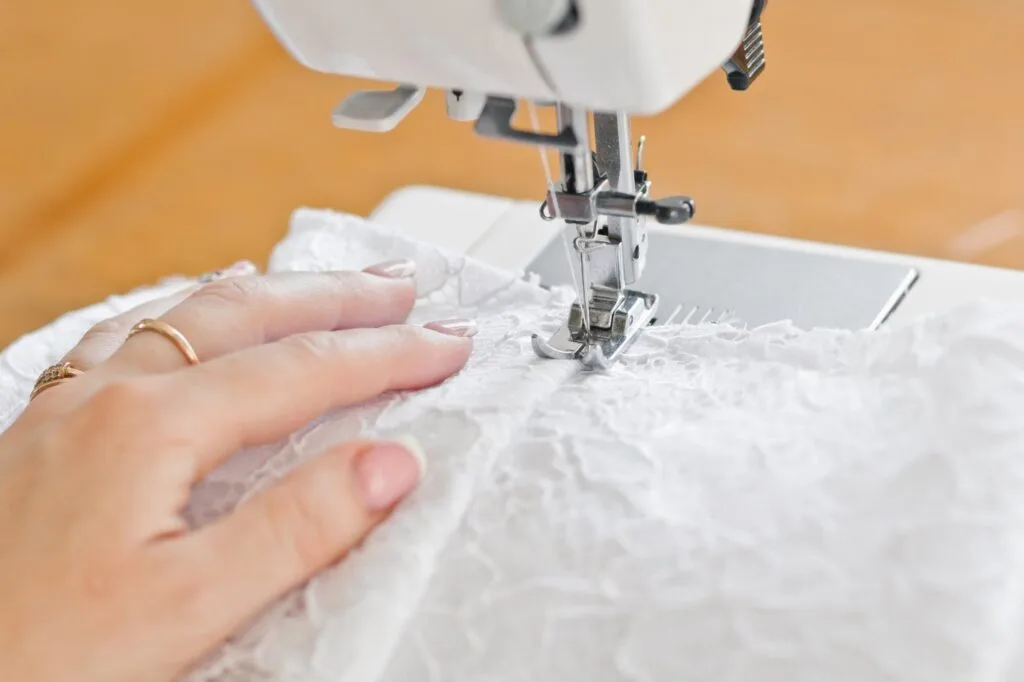
Working with corded lace requires different techniques than regular fabrics. Here’s how to get professional results.
Essential Tools and Supplies
Before you start, gather these items:
- Sharp fabric scissors for clean cuts through cords
- Fine ballpoint pins that won’t snag the mesh
- Universal or ballpoint needles (size 70/10 to 80/12)
- High-quality thread that matches your fabric
- Fabric clips as an alternative to pins in thick areas
- Seam ripper for corrections (mistakes happen!)
Check our essential sewing supplies guide for a complete list.
Cutting Techniques
Proper cutting sets you up for success:
- Lay fabric flat on your cutting surface – never cut while hanging
- Follow cord lines when possible to maintain pattern integrity
- Use pattern weights instead of pins to avoid shifting
- Cut with confident, smooth strokes to prevent cord fraying
- Mark notches carefully using washable fabric markers
For more cutting tips, see our fabric cutting guide.
Seam Construction Methods
Standard Seams:
- Use a slightly longer stitch length (2.5-3.0mm)
- Sew slowly to navigate around thick cord areas
- Press seams open when possible to reduce bulk
French Seams:
- Perfect for delicate corded lace
- Encases raw edges for a professional finish
- Takes more time but worth it for quality pieces
Flat-Fell Seams:
- Great for heavier corded lace
- Creates strong, finished seams
- Ideal for structured garments
Handling Thick Cord Areas
When your machine struggles with thick cord intersections:
- Hand-walk the machine by turning the handwheel manually
- Use a zipper foot to get closer to thick areas
- Trim cord ends slightly to reduce bulk (test first!)
- Grade seam allowances by trimming different layers to different lengths
Troubleshooting Common Issues
Problem: Puckering around cords
- Solution: Loosen thread tension and use a walking foot
Problem: Skipped stitches
- Solution: Switch to a ballpoint needle and slow down
Problem: Cords catching on presser foot
- Solution: Use a roller foot or walking foot
Problem: Uneven feeding
- Solution: Support fabric weight with your hands, don’t pull
Learn more about fixing sewing problems in our common sewing mistakes guide.
Project Ideas and Applications
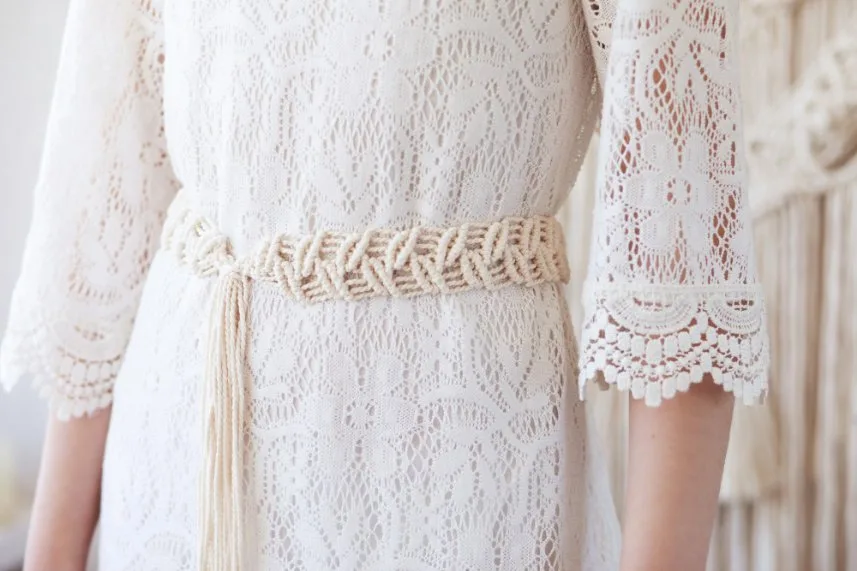
Corded lace works beautifully in many different types of projects. Here are some ideas to inspire your next creation.
Bridal and Formal Wear
Wedding Dresses:
- Use heavyweight corded lace for structured bodices
- Layer lightweight versions over satin for depth
- Consider ivory or champagne colors for timeless appeal
Evening Gowns:
- Mix corded lace with flowing fabrics like chiffon
- Try metallic cord details for glamorous evening looks
- Use contrasting colors for bold, modern designs
Formal Accessories:
- Create elegant wraps and stoles
- Design decorative belts and sashes
- Make matching hair accessories
Everyday Clothing Updates
Blouse Enhancements:
- Add corded lace sleeves to plain tops
- Create decorative neckline trim
- Design elegant cuff details
Skirt Modifications:
- Insert lace panels in solid-colored skirts
- Create layered hem treatments
- Add texture to simple A-line designs
Dress Transformations:
- Convert casual dresses to special occasion wear
- Add romantic touches to vintage finds
- Create unique overlay effects
Home Decor Projects
Window Treatments:
- Design elegant curtain panels
- Create decorative valances
- Make romantic cafe curtains
Table Linens:
- Craft special occasion tablecloths
- Design elegant runners and placemats
- Create decorative napkin rings
Decorative Accents:
- Make throw pillow covers
- Design picture frame embellishments
- Create wall hanging art pieces
Vintage Restoration Projects
Corded lace is perfect for updating vintage clothing:
- Assess the original garment for areas needing reinforcement
- Choose lace that complements the original style and era
- Add strategic panels where the original fabric is worn
- Blend old and new for a fresh but authentic look
2025 Trends in Corded Lace
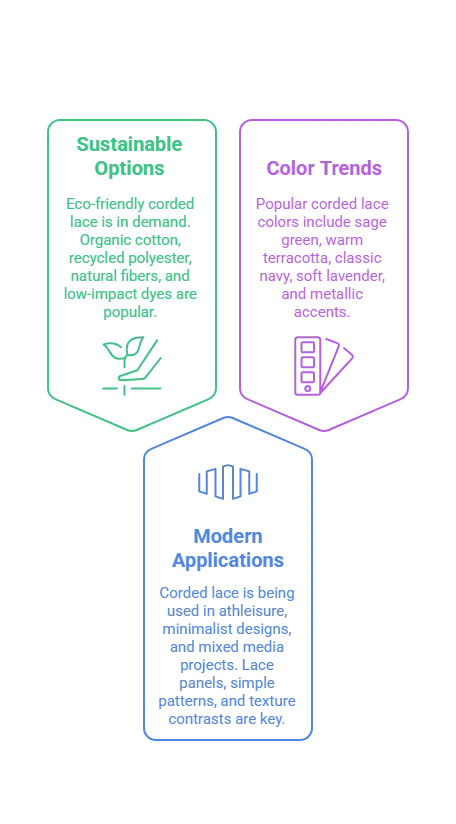
Fashion trends influence how we use corded lace in our projects. Here’s what’s popular this year:
Sustainable Options
Environmental consciousness is driving demand for eco-friendly corded lace:
- Organic cotton blends that are GOTS certified
- Recycled polyester options made from post-consumer materials
- Natural fiber cords using hemp or bamboo
- Low-impact dye processes that use less water and chemicals
Modern Applications
Athleisure Integration:
- Lace panels in workout wear
- Decorative sports bra details
- Elegant yoga wear accents
Minimalist Designs:
- Clean, simple cord patterns
- Monochromatic color schemes
- Geometric rather than floral motifs
Mixed Media Projects:
- Combining lace with leather
- Pairing with technical fabrics
- Creating texture contrasts
Color Trends for 2025
This year’s popular corded lace colors include:
- Sage green for natural, calming looks
- Warm terracotta for earth-inspired designs
- Classic navy for sophisticated elegance
- Soft lavender for romantic, feminine projects
- Metallic accents in gold and silver for luxury touches
For more on this year’s colors, see our 2025 fashion color predictions.
Video Tutorial: Working with Corded Lace
Key points the video would cover:
- Proper fabric handling to protect cords
- Cutting techniques that preserve pattern integrity
- Machine settings for smooth sewing
- Pressing methods that maintain texture
Buying Guide and Quality Assessment

What to Look for When Shopping
High-Quality Indicators:
- Consistent cord thickness throughout the pattern
- Even tension in the base mesh
- Clean, well-defined pattern edges
- Cords that don’t pull away from the base easily
Red Flags to Avoid:
- Loose or unraveling cords
- Uneven pattern spacing
- Thin or weak base fabric
- Poor color consistency
Where to Buy Quality Corded Lace
Online Retailers:
- Mood Fabrics for designer options
- Fabric.com for variety and value
- B&J Fabrics for luxury selections
Local Sources:
- Specialty bridal fabric stores
- High-end sewing centers
- Fabric districts in major cities
International Options:
- European suppliers for traditional styles
- Asian manufacturers for contemporary designs
- Specialty importers for unique patterns
Always order samples before purchasing large quantities, especially for important projects like wedding dresses.
Price vs. Value Considerations
Remember that higher price doesn’t always mean better quality for your specific project. Consider:
- Project lifespan – Is this for a one-time special event or everyday wear?
- Construction requirements – Does your design need the structure of expensive cords?
- Personal skill level – Are you comfortable working with delicate, expensive materials?
- Budget balance – Sometimes spending more on fabric means you can invest less in professional alterations
Frequently Asked Questions
Can I machine wash corded lace?
It depends on the fiber content. Polyester blends can usually handle gentle machine washing, while cotton and silk blends need hand washing. Always check the care label and test a small piece first.
What needle size should I use for sewing corded lace?
Use a ballpoint or universal needle in size 70/10 to 80/12. The exact size depends on your fabric weight – lighter laces need smaller needles, heavier ones need larger needles.
How do I prevent the cords from flattening when I press?
Always use a press cloth and work from the wrong side when possible. Use steam sparingly and press rather than dragging the iron across the fabric.
Can I alter corded lace garments?
Yes, but it’s trickier than altering regular fabrics. Plan alterations carefully to avoid cutting through important cord details. Sometimes it’s worth paying a professional for complex alterations.
Why is some corded lace so expensive?
Price reflects several factors: fiber quality (silk costs more than polyester), manufacturing complexity (hand-guided cording is more expensive), pattern intricacy, and brand prestige. European-made laces often command premium prices.
How much corded lace do I need for my project?
This depends on your pattern and design. Buy 10-20% extra for practice pieces and potential mistakes. Complex patterns may require more fabric to match motifs at seams.
Can beginners work with corded lace?
Absolutely! Start with simpler projects like pillowcases or scarves before tackling complex garments. Choose medium-weight polyester blends for your first projects – they’re forgiving and affordable.
How do I store corded lace long-term?
Roll the fabric around a tube rather than folding to prevent permanent creases in the cord areas. Store in a cool, dry place away from direct sunlight.
Troubleshooting Guide

Common Problems and Solutions
Cord Fraying During Cutting:
- Use very sharp scissors
- Cut with confident, smooth strokes
- Seal cut edges with fray-check if necessary
Machine Jamming on Thick Areas:
- Slow down your sewing speed
- Use a walking foot or roller foot
- Hand-walk through difficult spots
Uneven Seam Lines:
- Mark seam lines with washable markers
- Use a seam guide or edge foot
- Practice on scraps first
Cord Distortion After Washing:
- Reshape while damp
- Use fabric weights while drying
- Press gently with steam if needed
Advanced Techniques

Creating Custom Cord Effects
Adding Your Own Cording: Sometimes you might want to add extra cord details to plain lace:
- Choose cording that matches your fabric weight
- Baste the cord in place before final stitching
- Use a zipper foot to stitch close to the cord
- Trim excess cord at seam lines
Mixing Cord Types: Combine different cord thicknesses for interesting effects:
- Use thick cords for main pattern lines
- Add fine cords for detail work
- Try metallic cords for special accents
Professional Finishing Techniques
Scalloped Edge Finishing: Many corded laces have scalloped edges that need special handling:
- Trim carefully along the scallop line
- Use small, sharp scissors for clean cuts
- Finish with a narrow zigzag stitch if needed
Matching Patterns at Seams: For professional results, match cord patterns where pieces meet:
- Plan your layout carefully
- Mark matching points before cutting
- Baste pieces together before final stitching
- Adjust seam allowances if necessary
Sustainability and Environmental Impact
Eco-Friendly Options
The fashion industry is becoming more environmentally conscious, and corded lace manufacturers are responding:
Organic Materials:
- GOTS-certified organic cotton cords
- Low-impact dye processes
- Reduced water usage in manufacturing
Recycled Content:
- Post-consumer recycled polyester
- Reclaimed natural fibers
- Closed-loop manufacturing systems
Local Production:
- Supporting regional manufacturers
- Reducing transportation emissions
- Preserving traditional craft skills
Making Sustainable Choices
When choosing corded lace for your projects:
- Buy quality pieces that will last for years
- Choose versatile colors that work with multiple projects
- Save scraps for small accent projects
- Consider secondhand options for vintage and designer pieces
- Support manufacturers with sustainable practices
Learn more about sustainable fashion in our fast fashion vs slow fashion guide.
Conclusion
Corded lace offers endless possibilities for creating beautiful, textured projects that stand out from ordinary fabrics. Whether you’re crafting a once-in-a-lifetime wedding dress or adding elegant touches to everyday clothing, understanding this special fabric helps you make better choices and achieve professional results.
Key Takeaways
For Beginners:
- Start with affordable polyester blends to practice techniques
- Choose medium-weight fabrics for easier handling
- Invest in proper tools – sharp scissors and the right needles make a huge difference
- Don’t be afraid to practice on scraps before cutting your main fabric
For Experienced Sewers:
- Experiment with different cord types and weights for unique effects
- Consider sustainability when choosing materials
- Master advanced techniques like pattern matching for professional results
- Stay current with trends while maintaining your personal style
For All Skill Levels:
- Proper care and storage protect your investment
- Understanding fiber content helps you choose the right fabric for each project
- Quality matters more than price for important projects
- When in doubt, order samples before committing to large purchases
Final Recommendations
Best Value Options:
- Polyester blends for practice and casual projects ($15-40/yard)
- Cotton blends for quality garments with moderate budgets ($50-120/yard)
Luxury Choices:
- Silk blends for special occasion wear ($150-390/yard)
- European-made laces for heirloom projects
Most Versatile:
- Medium-weight cotton-polyester blends in ivory or navy
- Simple floral or geometric patterns that work with multiple styles
Remember, the most expensive fabric isn’t always the best choice for your specific project. Consider your skill level, the garment’s intended use, and your budget when making decisions. With proper planning and care, corded lace can help you create stunning pieces that you’ll treasure for years to come.
Whether you’re updating a vintage dress, creating a new bridal gown, or adding elegant touches to home decor, corded lace brings a level of sophistication and texture that regular fabrics simply can’t match. Take your time, practice the techniques, and enjoy the process of working with this beautiful material.
For more sewing tips and techniques, explore our complete beginners guide to sewing and discover additional fabric types to expand your crafting repertoire.


